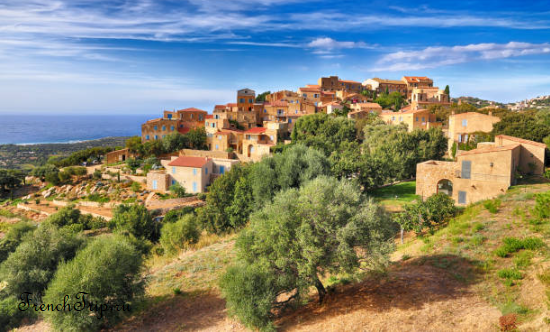Sant’Antonio
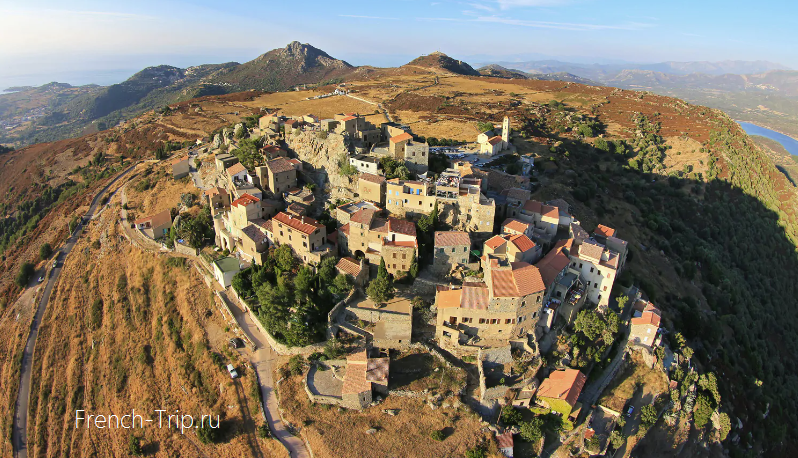
Sant’Antonino is a village situated on the Corsican hills between Calvi and L’Île-Rousse, listed among the “most beautiful villages of France.” Moreover, it is the oldest village on Corsica, with entry for cars prohibited.
The well-preserved village is located on top of a granite hill, surrounded by the beautiful rural countryside of Balagne with its olive trees and vineyards (the Balagne region in northwest Corsica is often called the garden of Corsica). As in almost all villages in the Balagne region, one of Sant’Antonino’s attractions is the view approaching the village with its ancient houses spread along the hilltop.
Sant’Antonino is located in Upper Corsica with a population of about 110 people, situated 14 km from L’Île-Rousse and less than 5 km from the coast and beaches.
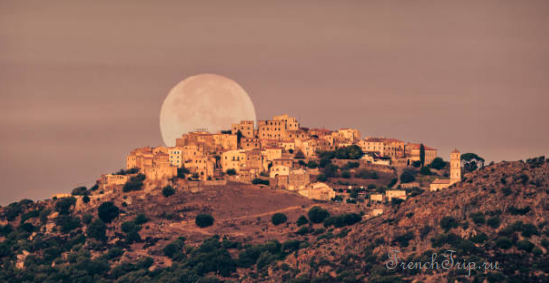
Sant’Antonino travel guide
This hilltop village in the Balagne region, built in the 9th century, is one of the oldest in Corsica. It is also one of the most beautiful villages in France! Its narrow streets are lined with beautiful houses that have been tastefully restored. Local craft workshops can also be visited. Thanks to its exceptional geographic location, Sant’Antonino offers stunning panoramic views of the coast, especially towards Calvi and L’Île-Rousse.
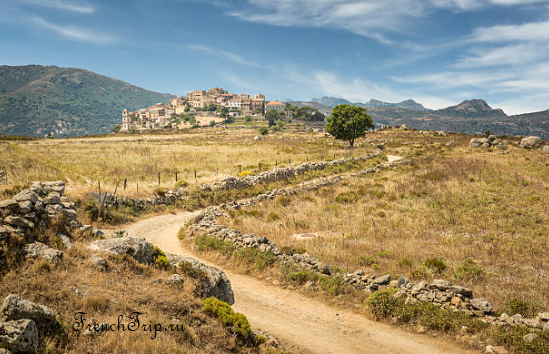
The village was founded in the 9th century by the Roman count Ugo Colonna. As a strategic “eagle’s nest,” Sant’Antonino served as a defensive point and an ideal observation post with a panoramic view for monitoring the sea and the plain.
The remains of the medieval castle and the traditional Corsican architecture of its 75 stone houses create the charm of this village today. As a member of the Association of the Most Beautiful Villages of France, Sant’Antonino is a must-visit during a trip to the Isle of Beauty.
The village’s popularity stems not from specific attractions but from its cobblestone pathways, high stone buildings, cactus and agave-lined paths, and the overall atmosphere that makes you feel like you’ve stepped back in time. This is complemented by the magnificent scent of the surrounding “maquis” or shrubland.
Why to visit?
You’ll quickly fall in love with this place. First, savor the serenity of this eagle’s nest. Leave your car at the village entrance and walk in the footsteps of Ugo Colonna, the renowned Roman count and founder of Sant’Antonino.
Immerse yourself in the Middle Ages… Explore the narrow streets and discover the 75 houses carved into the rock using local stones. These homes are interconnected and spiral around the granite outcrop, creating a maze-like experience.
As you pass through numerous archways, you’ll encounter the ancient bread oven and former wine press. Make your way to the top of the village, where the ruins of old fortifications await. Take a deep breath… and marvel at the stunning panoramic view of the entire Balagne region from this vantage point!
Getting to Sant’Antonino
Cars are not allowed in the village itself – since it is the oldest village on Corsica, built in the 9th century, there was little provision for cars during its original development!
However, there is a large paid parking lot near the church, just below the village, so parking is usually not difficult. But in July and August, the peak season, it’s best to arrive early in the morning or later in the evening.
- Travel time from L’Île-Rousse = 30 minutes.
- Travel time from Calvi = 30 minutes.
- Travel time from Pigna = 15 minutes.
You need to detour from the T30 road on the west coast. The last few kilometers are along the D151 road and then the D413 road. Both roads have one lane in each direction, though some sections are slightly narrower. It’s a mountain road, but without overly sharp turns.
You can also travel on foot between different villages: it takes about 45 minutes to walk from Sant’Antonino to Pigna.
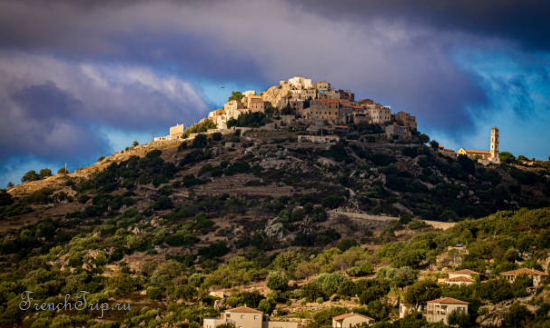
Useful tips
- There are many steps and steep stairs leading to the village center. Wear good walking shoes as the ground is rocky and very uneven.
- The village interior is almost entirely pedestrianized.
- Restrooms are located at the parking level.
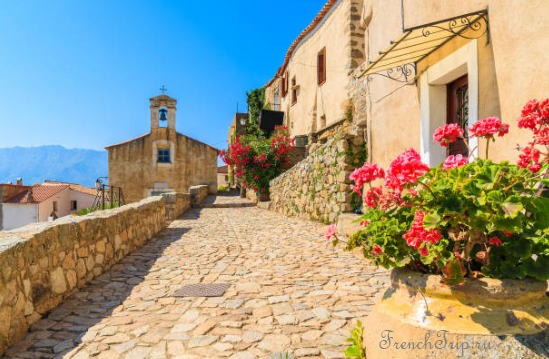
Finding your way in Sant’Antonino
At the entrance to the village, you will find a map of Sant’Antonino, showing various landmarks and starting points for walking routes. The map is oriented geographically (west-east with parking to the east), though it would be more convenient if it showed the parking at the bottom… But don’t worry, the village is small, and there’s no risk of getting lost.
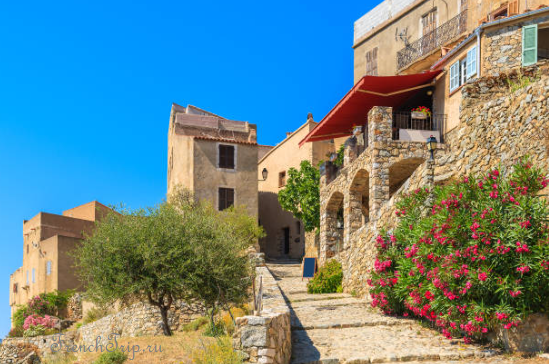
History of Sant’Antonino
Legend has it that the village of Sant’Antonino dates back to the early 9th century, when a defensive tower was built on this site. The first families settled here in the 14th century. Since then, the village grew, as did the power struggles among clan leaders.
Sant’Antonino began to flourish in the 16th century. Residents turned it into a garden. Almost everyone lived off the land. All the land, even on the slopes, was cultivated: olive trees, vineyards, almond trees, wheat, barley…
Families grew, and so did the houses: by the early 19th century, the village had 75 houses, some of which were 3-4 stories high!
Attractions in Sant’Antonino
The attractions of Sant’Antonino begin right at the parking lot:
Church of the Annunciation
Near the parking lot, on the outskirts of Sant’Antonino, is the Church of the Annunciation (A Nunziata), built in the 11th century. Inside, besides the 1744 organ (the work of Battista Pompost di Pistoia), there are four paintings classified as historical heritage: “Deposition of the Cross with Four Donors” (17th century), “Flight into Egypt” (18th century), “Souls in Purgatory” (undated), and “Madonna of the Rosary with Saints Dominic and Catherine of Siena” (18th century).
Behind the church, you can see the Chapel de Confrérie.
From here, you can now follow the path leading to the center of the historic village of Sant’Antonino.
Old Town of Sant’Antonino
Numerous old houses, whose appearance has not changed over the centuries, line the labyrinth of narrow cobblestone streets of the village. As you walk through the vaulted corridors and climb the steep cobblestone stairs, you almost feel like you’ve traveled back 500 years.
Among the small attractions, you will notice the old bread oven and wine press, and two small chapels: the Chapel of Saint Anne (Chapel Sainte-Anne) and the Chapel des Bergers in the village, and the Chapel Notre-Dame de Lavasina on a small square above (Piazza Savelli Spinosi) with a recently restored façade.
Walking around, it’s impossible not to notice how the massive granite, from which the buildings are constructed, harmoniously blends with the hillside itself, and they often seem almost inseparable…
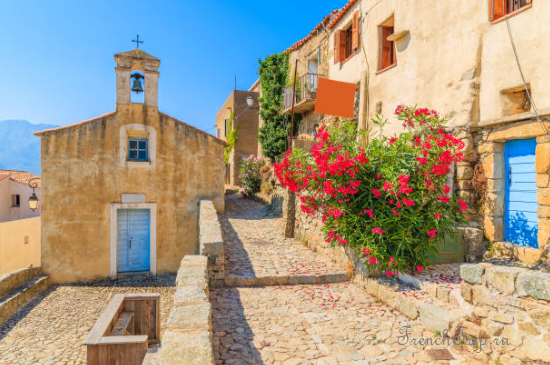
Panoramic view of surroundings
From the highest point in Sant’Antonino, you get a magnificent view of both the sea and the mountains. You can also see the remnants of a fortified building that once stood here, built around the 9th century. Unusually for such a village, right at the hilltop in Sant’Antonino, there is a café with an open rooftop terrace where you can have a coffee with views of the mountains in all directions. Very impressive!
Elsewhere in Sant’Antonino, you’ll find various small shops and restaurants, some with terraces offering stunning views.
Church of the Trinity and San Giovanni
There is another building that also has an “administrative” peculiarity: the Church of the Trinity and San Giovanni, built in the middle of the cemetery, which belongs to the neighboring commune of Aregno but is located within the territory of Sant’Antonino. The church is of Pisan style, dating back to the 11th century.
Since the public area of the village is very limited (4 km²), all other cultural and recreational activities are located outside the settlement.
Overall, in the “most beautiful village on Corsica,” which is visited by a large number of visitors every year, there is less “tourist activity” than one might expect.
Hiking Routes
If you want to enjoy more of the Balagne region’s landscapes, set off on one of the numerous hikes around Sant’Antonino. With routes ranging from 2.5 km to 12 km, everyone can find the perfect trail and admire the region.
Be careful, there will be little shade, so take sun protection and bring water.
- Circular route Piève d’Aregnu, including several villages (complete loop is about 10 km).
- Route to the village of Pigna = 45 minutes one way.
- Route to the village of Corbara = 1 hour 30 minutes one way.
Dining in Sant’Antonino
In the village center, there are several small cafes and restaurants. Prices are fairly uniform, with main dishes costing around €20-25.
- U Laziu, near the parking lot, in front of the stairs
- Restaurants La Voute, La Taverne Corse, I Scalini, and A Casa Corsa with views to the east.
- In Stalla with views to the west
The restaurants in the village generally have good ratings.
You can visit the restaurant I Scalini (in season – daily 9am-2pm / 6pm-11pm) with a rooftop terrace in Moroccan style and a stunning view of the village and surrounding hills. Plus, the bathroom is very interesting!
Festivals and Holidays
Festival of Saint Roch (Saint-Roch), August 16: after religious ceremonies (mass, procession, blessing of animals), there are meals, folkloric and musical entertainment.
Around Sant’Antonino
Below the village, near Aregno, you should visit the beautiful Church of the Trinity and San Giovanni.
This church was built in the 11th century in the Pisan style using a mix of light and dark stone and includes many original elements and medieval statues (note: this church is near Aregno, not the church in the village center, which is less interesting).
You will most likely end up in Sant’Antonino as part of a tour of the villages of Balagne. Here in the hills there are many small picturesque villages. Nearby favorites include Pigna and Corbara.
Sant’Antonino on the map of Corsica
Archives
Calendar
| M | T | W | T | F | S | S |
|---|---|---|---|---|---|---|
| 1 | 2 | 3 | 4 | 5 | 6 | 7 |
| 8 | 9 | 10 | 11 | 12 | 13 | 14 |
| 15 | 16 | 17 | 18 | 19 | 20 | 21 |
| 22 | 23 | 24 | 25 | 26 | 27 | 28 |
| 29 | 30 | 31 | ||||
